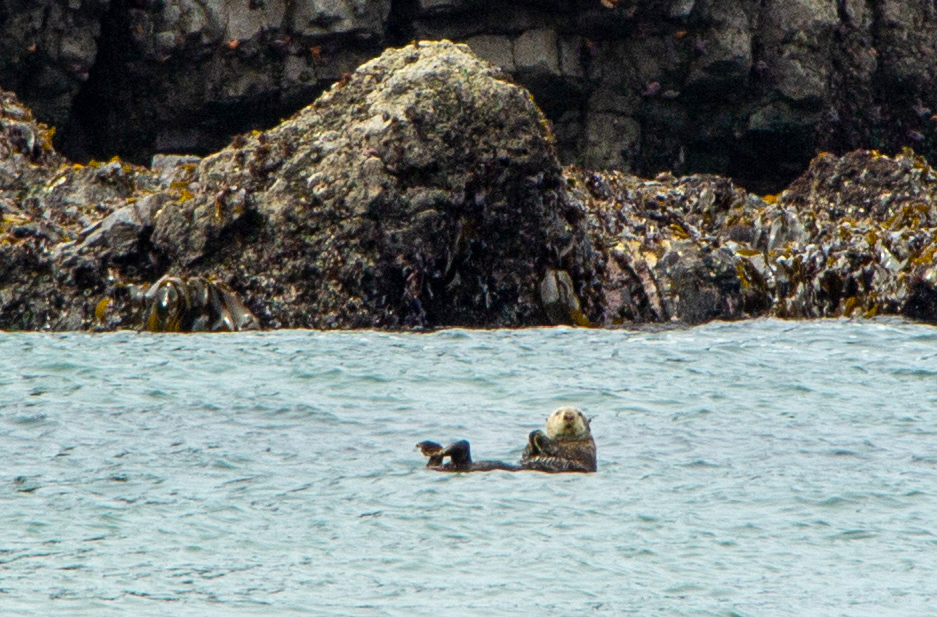
Sea Otters Return to Oregon Coast, but Population Growth UnlikelySea Otters Return to Oregon Coast, but Population Growth Unlikely Two male sea otters have been spotted in Cannon Beach, a rare sight for Oregonians. However, biologists do not expect a larger population explosion in the near future. Sea otters were exterminated by fur trappers in the early 1900s, leaving Oregon as the only state on the West Coast without them. The nearest population is about 100 miles away. Chanel Hason, a biologist with Elakha Alliance, confirmed the sightings after initially mistaking them for river otters. River otters are common along the Oregon coast but spend more time on land. The two male otters are believed to be from the northern Washington subspecies and may have strayed from the pack in search of females. However, Hason notes that female sea otters typically stay with their pack and rarely join males. About a handful of dead sea otters wash up on the Oregon coast each year, but their cause of death is often unknown. Elakha Alliance is working to reintroduce sea otters to Oregon as they play a crucial role in the ecosystem. They help balance the sea urchin population by feeding on them, which prevents kelp forests from being decimated. In Oregon, sunflower sea stars once kept sea urchins in check, but most were wiped out by sea star disease. Hason emphasizes that the return of these two otters does not guarantee a natural resettlement. Biologists are studying their foraging habits to understand how sea otters would behave if a population were reintroduced to the state.
By APRIL ERHLICH/Oregon Public Broadcasting
It appears that two male sea otters call Cannon Beach home. It’s a rare sight for Oregonians visiting Ecola Point.
However, biologists do not expect a larger population explosion in the near future, since female sea otters typically do not migrate far from home, with the nearest population being about 100 miles away.
A group of conservationists from the nonprofit Elakha Alliance documented multiple sightings of sea otters through June, first reported by the Cannon Beach Gazette. The creatures have rarely been seen in the state since they were exterminated by fur trappers in the early 1900s.
When Chanel Hason, a biologist and communications director for the Elakha Alliance, first heard about a sea otter swimming off the Oregon coast, she thought it was probably a common river otter. So she drove to Ecola Point to see it for herself.
“And then, lo and behold, there were two of them, which I’ve never seen happen along the Oregon coast before,” Hason said.

 On June 28, a sea otter appears off the coast of Ecola Point in Cannon Beach. Photo courtesy of Chanel Hason
On June 28, a sea otter appears off the coast of Ecola Point in Cannon Beach. Photo courtesy of Chanel Hason
Oregon is the only state on the West Coast that no longer has sea otters. About 2,000 live around Washington’s Olympic Peninsula, and some populations are scattered along California’s central coast.
River otters are common along the Oregon coast and other areas west of the Cascades, but they hunt in both freshwater and saltwater environments and spend more time on land. They have four legs, their movements are quick and agile, and they swim on their bellies.
Sea otters, on the other hand, swim on their backs, spend most of their time in the ocean, and have large flippers for hind feet, making it more difficult for them to walk on land.
Hason said these two males appear to be from the northern Washington sea otter subspecies. They may have strayed from the pack in search of females. The likelihood of female sea otters joining them is highly unlikely, Hason said, since females tend to stay with the pack. Sometimes males will leave if they are sick or looking for a mate, but females rarely join them.
“So even though we see two (sea otters) off Cannon Beach now, that doesn’t mean they’re just going to naturally resettle because that’s just not how it works,” Hason said.
About a handful of dead sea otters wash up on the Oregon coast each year, Hason said. They are usually so decomposed that biologists can’t determine how they died, though sometimes they have telltale shark bite marks. Hanson said biologists aren’t sure how these carcasses end up there.
The Elakha Alliance is a conservation group based in Siletz with a mission to reintroduce sea otters to Oregon. To do this, the company hopes to recruit a population from another state. In 2022, the U.S. Fish and Wildlife Service published a report concluding that reintroducing sea otters to Oregon and Northern California was feasible and environmentally sound. It is unclear whether the agency will initiate the reintroduction.
Sea otters are what biologists call a “keystone species,” because they play a crucial role in balancing their ecosystems. By feeding on sea urchins, they help prevent that population from decimating kelp forests. In Oregon, sunflower sea stars kept the sea urchin population in check, but most were wiped out by sea star disease between 2013 and 2015.
“Without these two predators in the ecosystem, these sea urchins are thriving and eating kelp forests at an alarming rate,” Hason said. “It’s really bad.”
Hason said it’s unclear whether these two sea otters will stay once they realize there are no more females. In the meantime, local biologists are studying their foraging habits to understand how sea otters would behave if a population were reintroduced to the state.